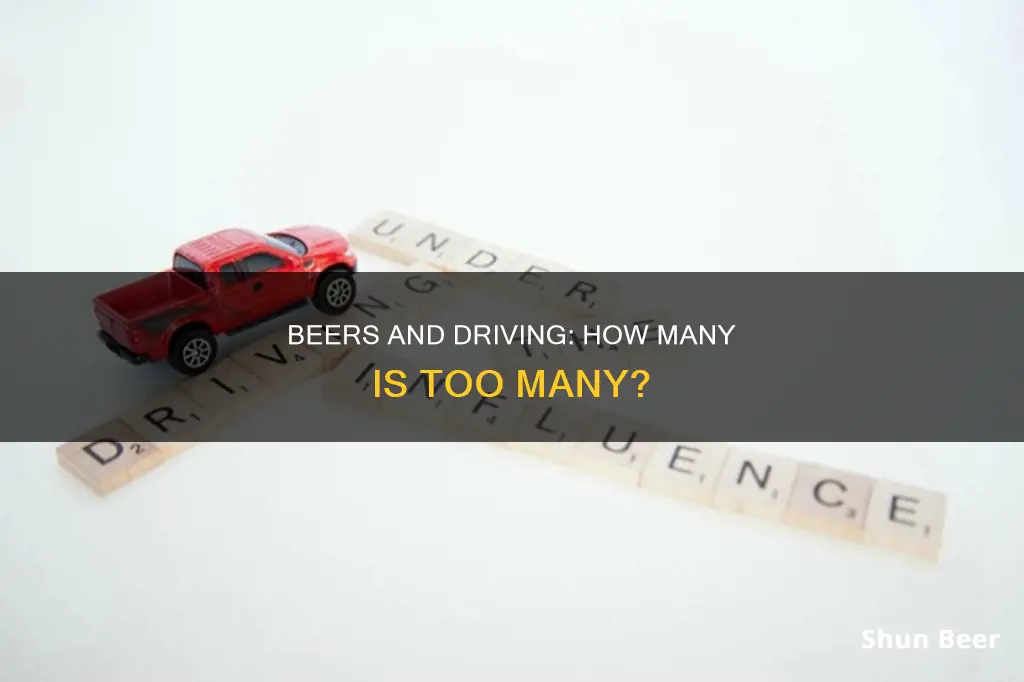
Drinking and driving is a serious offence that can have life-altering consequences. While the legal blood alcohol content (BAC) limit for driving is 0.08% in most US states, and 0.05% in Utah, the number of beers one can consume before reaching this limit varies depending on several factors, including weight, gender, metabolic rate, and food consumption. As a general rule of thumb, it takes around 4-5 beers for an average-sized person to reach a BAC of 0.08%. However, it is important to remember that everyone's body is different, and factors such as body composition, metabolism, and the alcohol content of the beer can also affect BAC levels. Ultimately, the safest blood alcohol level for driving is zero, and it is always best to err on the side of caution and not drive after consuming any alcohol.
| Characteristics | Values |
|---|---|
| Legal Blood Alcohol Level | 0.08% in all but one state |
| Legal Blood Alcohol Level in Utah | 0.05% |
| Number of Beers for an Average-Sized Person to Reach Legal Limit | 4-5 |
| Number of Beers for a 180-lb Man to Keep BAC Below Legal Limit | 3.5 in one hour |
| Number of Beers for a 140-lb Woman to Keep BAC Below Legal Limit | 2.5 in one hour |
| Number of Beers for a 100-lb Woman to Keep BAC Below Legal Limit | 2 in one hour |
| Number of Beers for a 130-lb Woman to Keep BAC Below Legal Limit | 3 in one hour |
| Number of Beers for a 150-lb Man to Keep BAC Below Legal Limit | 2 in one hour |
| Number of Beers for a 200-lb Man to Keep BAC Below Legal Limit | 3 in one hour |
| Metabolism Rate | Varies by individual |
| Tolerance Level | Varies by individual |
What You'll Learn

The one drink an hour rule
The "one drink an hour" rule is a widely known guideline that people use to avoid surpassing the blood alcohol content (BAC) limit of 0.08%. This rule suggests that consuming no more than 1¼ ounces of hard liquor, one beer, or one glass of wine per hour will allow you to stay within the legal BAC limit and make you safe to drive. However, it's important to recognize that this rule is not a foolproof method for determining driving eligibility after drinking.
The effectiveness of the "one drink an hour" rule varies from person to person. Body composition, height, weight, body fat, and metabolism all play a significant role in how alcohol is processed by an individual. For example, a person with a higher metabolism may be able to process alcohol more quickly, requiring more drinks to reach the legal BAC limit. Conversely, a person with a lower metabolism may process alcohol more slowly, resulting in a faster rise in BAC.
Additionally, the type of alcohol consumed should be taken into account. Different alcoholic drinks can have varied effects on individuals. While beer or wine may have a relatively milder impact, hard liquor like vodka or tequila may induce a "drunker" feeling more quickly. The ABV (alcohol by volume) of the drink also matters; craft beers, IPAs, stouts, and ales often have higher ABV levels, which will impact how much you can consume while staying under the legal BAC limit.
It's crucial to understand that the "one drink an hour" rule is just a guideline and not a guarantee. The only sure way to avoid drunk driving is to refrain from driving after consuming alcohol. If you plan on drinking, it's always best to arrange alternative transportation methods, such as a designated driver, public transportation, or ridesharing services.
While the "one drink an hour" rule may provide a general framework, it's essential to recognize that everyone's body processes alcohol uniquely. Factors like body composition, metabolism, and the type of alcohol consumed can influence how alcohol affects you. As a result, it's always advisable to exercise caution and refrain from driving if you've been drinking, regardless of how many drinks you've had or how you feel.
Beer and Naproxen: Is It Safe to Mix?
You may want to see also

Factors influencing blood alcohol content (BAC)
It is important to note that there are many factors that influence an individual's blood alcohol content (BAC). These factors determine how quickly one's body can process alcohol and can vary from person to person. Here are some key factors that can affect BAC levels:
Body Composition and Chemistry
The unique composition and chemistry of each person's body play a significant role in how quickly they can metabolize alcohol. Factors such as weight, height, body fat, and muscle mass influence the rate of alcohol digestion and absorption. For example, individuals with a higher metabolism may process alcohol more quickly, requiring more drinks to reach the same BAC level as someone with a slower metabolism.
Rate of Consumption
The rate at which alcohol is consumed significantly impacts BAC levels. The faster an individual drinks, the quicker their BAC will rise, leading to faster intoxication. Generally, the liver can metabolize alcohol at a rate of about one standard drink per hour. However, if an individual consumes more than one drink per hour, their liver may not be able to keep up, resulting in a higher BAC level.
Food Consumption
Consuming food before or while drinking can slow down the absorption of alcohol into the bloodstream. Food in the stomach delays the passage of alcohol to the small intestine, where most of the alcohol enters the bloodstream. Fatty foods are particularly effective in slowing down alcohol absorption compared to carbohydrates, which pass through the stomach more quickly.
Alcohol Concentration
The concentration of alcohol in a drink also affects BAC levels. Drinks with higher alcohol content, such as hard liquor, can lead to faster absorption and higher BAC levels compared to drinks with lower alcohol concentrations. Additionally, different types of alcoholic beverages can have varying effects on individuals.
Gender
Gender is another factor that influences BAC levels. On average, men have more blood volume per kilogram of body weight than women, providing a greater dilution of alcohol. This means that for the same weight, men may have a slightly lower BAC level compared to women when consuming the same amount of alcohol.
Individual Tolerance
Tolerance to alcohol can vary among individuals. Long-term drinkers may develop a higher tolerance, and their livers may become more efficient at metabolizing alcohol. However, it is important to note that while a person with higher alcohol tolerance may not exhibit the outward signs of intoxication, their BAC level can still be high, and they are not safer to drive.
Medications
Certain medications can amplify the effects of alcohol on the body. Mixing alcohol with medications such as aspirin, tranquilizers, antidepressants, or cough medicines can lead to unpredictable and potentially dangerous interactions.
Fatigue, Stress, and Mood
Fatigue and stress can also influence how alcohol affects an individual. As alcohol is a depressant, it can exacerbate feelings of depression or stress. Additionally, alcohol can have a more pronounced effect on individuals who are fatigued.
Old Beer: Is It Safe to Drink After 20 Years?
You may want to see also

Metabolism and body composition
An individual's metabolic rate is a key factor in determining their Blood Alcohol Concentration (BAC). The liver, which is responsible for detoxifying the body of alcohol, metabolises alcohol at a constant rate of about one drink per hour. This rate is influenced by factors such as age, biological sex, body weight, food consumption, and other substances or medications. For example, females tend to metabolise alcohol differently and more slowly than males due to physiological factors such as lower body water volume and lower levels of the liver enzyme alcohol dehydrogenase (ADH). Similarly, age affects metabolism due to slowed circulation and lower muscle mass. Body weight also plays a role, as alcohol can diffuse more easily throughout the body in individuals with higher weights.
In addition to metabolic rate, body composition also influences BAC levels. For instance, individuals with higher body fat percentages may be considered "heavyweight" drinkers, as fat does not absorb blood, water, or alcohol, whereas muscle does. As a result, alcohol can only be distributed throughout the remaining lean tissue, resulting in a higher concentration in those areas. This is why individuals with higher body fat percentages may take longer to metabolise alcohol and may experience higher BAC levels compared to those with lower body fat percentages.
Furthermore, the presence of food in the stomach can significantly impact alcohol absorption. Food can physically obstruct alcohol from coming into contact with the stomach lining, or it can slow down the passage of alcohol into the small intestine, where most of the absorption occurs. Greasy, high-protein, and fatty foods are particularly effective in slowing down intoxication because they take longer to digest and stay in the stomach for a longer period.
It is important to note that the legal limit for operating a motor vehicle in the United States is a BAC of 0.08%. However, driving abilities can be impaired even at lower BAC levels. Therefore, it is recommended to refrain from drinking and driving altogether to ensure safety.
Beer Bar Memberships: Are They Worth the Cost?
You may want to see also

Different types of beer
It is important to note that the number of beers one can drink before driving depends on several factors, such as body weight, metabolic rate, and the alcohol content of the beer. The legal blood alcohol content limit for driving in the United States is 0.08%.
Now, let's explore the different types of beer:
Beer can be broadly categorized into two types: ales and lagers. The type of yeast used during the fermentation process is the key differentiator between these two categories. Ales are typically brewed with Saccharomyces cerevisiae, a top-fermenting yeast that works at temperatures between 60°F and 75°F. This allows for a faster brewing time and contributes to the complex flavors and aromas associated with ales. Common ale styles include pale ales, India pale ales (IPAs), stouts, porters, and brown ales.
On the other hand, lagers are brewed with Saccharomyces pastorianus, a bottom-fermenting yeast that ferments at cooler temperatures, ranging from 35°F to 55°F. Lagers are known for their smoother mouthfeel and lighter, more refreshing character, making them a versatile choice for beer enthusiasts. Some popular lager styles include Pilsners, Bocks, and Munich-style lagers.
Within these two main categories, there are numerous specialty beers that use unique ingredients and brewing techniques. For example, fruit beers, sour ales, and barrel-aged beers offer complex flavor profiles for those seeking new taste experiences.
One of the most popular beer styles is the India Pale Ale (IPA), known for its high hop content, which gives it a bitter, fruity, or floral flavor. IPAs tend to have a higher alcohol content, making them a stronger option.
Stouts are typically dark beers with a high alcohol content. They are characterized by their heavily roasted flavor notes, such as coffee, chocolate, licorice, or molasses.
Pilsners, a type of lager, have a heavier hop flavor than other lagers but not as strong as an IPA. They originated in Pilsen, Czech Republic, and are known for their dry, slightly bitter taste and low alcohol content, making them a refreshing choice.
Hefeweizen is another style of beer, an ale brewed mainly with wheat instead of other malts, resulting in a refreshing, fruity flavor.
Other notable beer styles include pale ales, porters, brown ales, wheat beers, sour ales, and specialty beers such as American black ales, barrel-aged beers, and gluten-free beers. Each of these styles has its unique characteristics, flavor profiles, and food pairing suggestions.
Beer and Librium: A Risky Mix?
You may want to see also

Legal consequences of drunk driving
Drinking and driving is a serious offence that can have severe legal consequences. Here are some of the legal implications to consider:
Criminal Offence and Penalties
Driving under the influence (DUI) is a criminal offence in the United States. The specific terminology may vary by state, with offences labelled as DUI, DWI (driving while intoxicated), or OUI (operating under the influence). Regardless of terminology, these offences carry generally severe penalties.
Blood Alcohol Content (BAC) Limit
Across all 50 states, a blood alcohol content (BAC) of 0.08% or higher is considered driving under the influence. However, it's important to note that you can still be arrested and charged with a DUI if you are impaired by alcohol, even if your BAC is below the legal limit.
License Suspension or Revocation
One of the most common consequences of a DUI is the suspension or revocation of your driver's license. The length of suspension varies by state, with some states imposing a 30-day suspension for a first offence, while others may suspend your license for a year or more. For repeat offences, some states may even revoke your license permanently.
Fines and Fees
DUI convictions typically come with hefty fines and fees. Even for a first-offence DUI, you can expect to pay at least $500 in fines, in addition to various fees such as license reinstatement and court fees, which can amount to several hundred dollars.
Jail Time
About half of the states in the US mandate jail time for a first DUI conviction, typically ranging from one day to a week. For second and subsequent offences, mandatory jail time becomes more common, with minimum sentences increasing accordingly.
Ignition Interlock Device (IID) Installation
Many states require individuals convicted of a DUI to install an ignition interlock device (IID) in their vehicles. An IID is a breathalyzer-like device that prevents the car from starting if it detects alcohol on the driver's breath. The installation and maintenance costs of an IID are usually borne by the defendant.
Employment and Background Checks
A DUI conviction can also impact your current and future employment prospects. Court dates, jail time, and community service requirements can interfere with your work schedule and may even result in job loss. Additionally, employers often conduct background checks, and a DUI conviction may make it more challenging to secure new employment.
Auto Insurance Rates
Following a DUI conviction, your auto insurance rates are likely to surge. Insurance companies consider drivers with DUI convictions as "high-risk," and your insurance premiums may double or triple for several years. In some cases, your insurance provider may even terminate your coverage.
In conclusion, driving under the influence of alcohol is a grave matter that can result in severe legal repercussions. The best way to avoid a DUI is to refrain from driving after consuming alcohol.
Beer and Tonsillitis: Is It Safe to Drink?
You may want to see also
Frequently asked questions
The safest blood alcohol level for driving is zero. It is best to avoid drinking and driving altogether.
In all but one state in the US, the legal blood alcohol level for driving is 0.08%. In Utah, the limit is 0.05%.
This depends on many factors, including weight, gender, metabolic rate, food consumption, and the ABV of the beer. As a rough guide, an average-sized person would typically need to limit themselves to 4-5 beers over two hours.
People with a higher metabolism may be able to process alcohol more quickly, meaning it may take more drinks for them to reach the legal limit.
Drinking on an empty stomach will increase your blood alcohol level. It is recommended to eat while drinking to slow the absorption of alcohol into the bloodstream.







